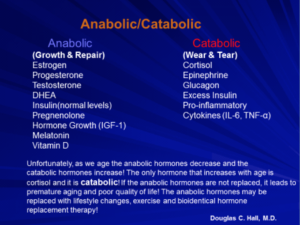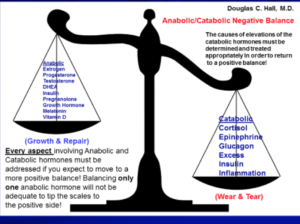At birth, we are blessed with a symphony of beautiful hormones that promote growth and repair. These hormones take single molecules and form complex molecules that are required for the body to function normally. These hormones are called anabolic hormones. There are other hormones that are called catabolic hormones and are involved in the wear and tear of the body. The key to quality of life and longevity is to maintain a positive balance of these hormones. This balance ensures that the anabolic hormones exceed the catabolic hormones and we continue to experience growth and repair of the tissues of the body. These hormones are listed below.
There are many factors that affect the levels and the balance of anabolic and catabolic hormones as an individual develops. These factors include nutrition, micronutrient status, type of exercise, stress, environmental toxins, adequate sleep, medications, genetics, lifestyle, and aging. All too often our beautiful symphony of anabolic hormones becomes out of tune and as a consequence the quality and length of one’s life suffers. There is more wear and tear and less growth and repair! There is an anabolic/catabolic imbalance! The medical literature contains multitudes of articles describing how this imbalance is associated with heart disease, type 2 diabetes, metabolic syndrome, hypertension, arthritis, and numerous other diseases!
Why is it that physicians do not address this anabolic/catabolic imbalance as a major factor in the disease process? Look at the hormones involved and the factors mentioned above that affect this balance. This is difficult! The health care professional must have an extensive knowledge of biochemical pathways and nutrition, how the hormones interact and all the cofactors that are required from these hormones to function at an optimal level. Time must be spent educating the patient on what he or she can do with regards to nutrition, proper exercise, adequate sleep, proper lifestyle, stress management and management of genetic mutations. The physician must have the knowledge of proper tests to order, knowing that replacing just one hormone is not adequate to tip the scales to the positive side. The hormone replacement must be bioidentical! A conductor of a great orchestra would not replace a measure in a piece of music played by a trumpet with a flute and expect the symphony to sound the same. Why should we give a synthetic hormone and expect the body to respond the same? What is the proper hormone replacement and how often should tests be repeated to determine if the therapy is effective? This is a very difficult task for the patient and the physician and requires total commitment of both parties. That commitment must be made if the anabolic/catabolic ratio needs to be returned to balance and to reduce the incidence of diseases and improve the quality and length of life! “Knowledge is of no value unless you put it into practice.” Anton Chekhov
“We must all suffer one of two things: the pain of discipline or the pain of regret.” Jim Rohn
Int J Biochem Cell Biol. 2005 Oct; 37 (10): 2023-35
Curr Heart Fail Rep. 2014 Mar; 11 (1):70-9
Int J Androl. 2011 Dec; 34 (6 Pt 2):e594-600
Douglas C. Hall, M. D.





